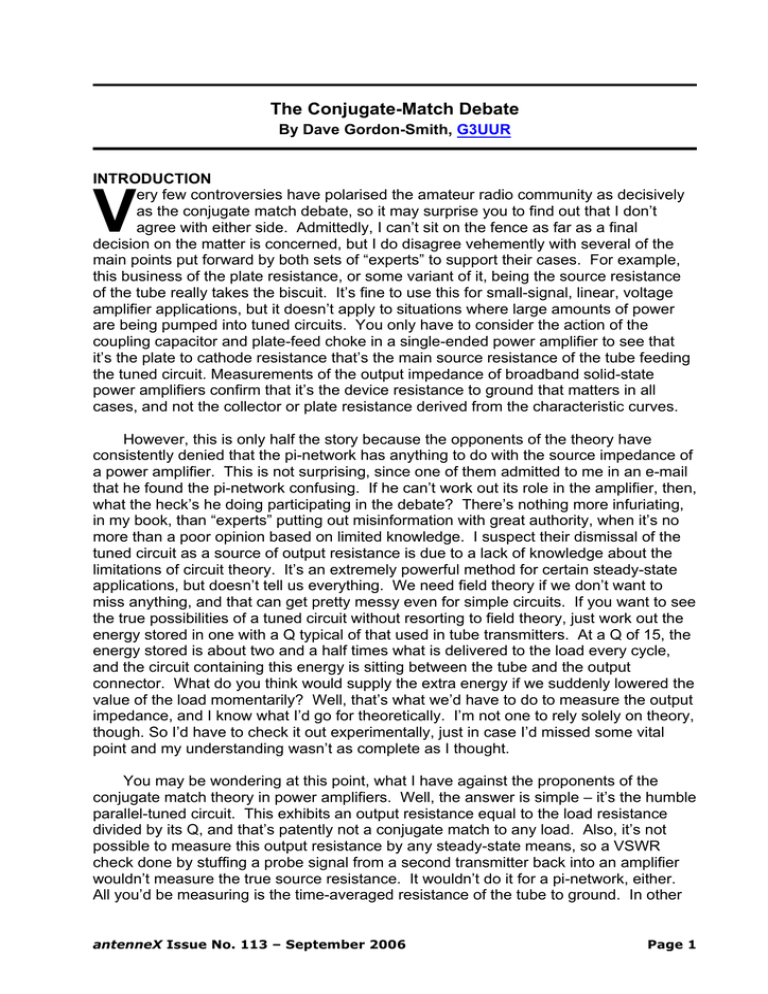
The Conjugate-Match Debate
By Dave Gordon-Smith, G3UUR
INTRODUCTION
ery few controversies have polarised the amateur radio community as decisively
as the conjugate match debate, so it may surprise you to find out that I don’t
agree with either side. Admittedly, I can’t sit on the fence as far as a final
decision on the matter is concerned, but I do disagree vehemently with several of the
main points put forward by both sets of “experts” to support their cases. For example,
this business of the plate resistance, or some variant of it, being the source resistance
of the tube really takes the biscuit. It’s fine to use this for small-signal, linear, voltage
amplifier applications, but it doesn’t apply to situations where large amounts of power
are being pumped into tuned circuits. You only have to consider the action of the
coupling capacitor and plate-feed choke in a single-ended power amplifier to see that
it’s the plate to cathode resistance that’s the main source resistance of the tube feeding
the tuned circuit. Measurements of the output impedance of broadband solid-state
power amplifiers confirm that it’s the device resistance to ground that matters in all
cases, and not the collector or plate resistance derived from the characteristic curves.
V
However, this is only half the story because the opponents of the theory have
consistently denied that the pi-network has anything to do with the source impedance of
a power amplifier. This is not surprising, since one of them admitted to me in an e-mail
that he found the pi-network confusing. If he can’t work out its role in the amplifier, then,
what the heck’s he doing participating in the debate? There’s nothing more infuriating,
in my book, than “experts” putting out misinformation with great authority, when it’s no
more than a poor opinion based on limited knowledge. I suspect their dismissal of the
tuned circuit as a source of output resistance is due to a lack of knowledge about the
limitations of circuit theory. It’s an extremely powerful method for certain steady-state
applications, but doesn’t tell us everything. We need field theory if we don’t want to
miss anything, and that can get pretty messy even for simple circuits. If you want to see
the true possibilities of a tuned circuit without resorting to field theory, just work out the
energy stored in one with a Q typical of that used in tube transmitters. At a Q of 15, the
energy stored is about two and a half times what is delivered to the load every cycle,
and the circuit containing this energy is sitting between the tube and the output
connector. What do you think would supply the extra energy if we suddenly lowered the
value of the load momentarily? Well, that’s what we’d have to do to measure the output
impedance, and I know what I’d go for theoretically. I’m not one to rely solely on theory,
though. So I’d have to check it out experimentally, just in case I’d missed some vital
point and my understanding wasn’t as complete as I thought.
You may be wondering at this point, what I have against the proponents of the
conjugate match theory in power amplifiers. Well, the answer is simple – it’s the humble
parallel-tuned circuit. This exhibits an output resistance equal to the load resistance
divided by its Q, and that’s patently not a conjugate match to any load. Also, it’s not
possible to measure this output resistance by any steady-state means, so a VSWR
check done by stuffing a probe signal from a second transmitter back into an amplifier
wouldn’t measure the true source resistance. It wouldn’t do it for a pi-network, either.
All you’d be measuring is the time-averaged resistance of the tube to ground. In other
antenneX Issue No. 113 – September 2006
Page 1
words, it’s the effective dissipation resistance of the tube that’s terminating the input end
of the pi-network. The input and output resistance of the pi-network is non-dissipating,
and is only evident in the build up to equilibrium or when there is a momentary change
in the value of the load. It can’t be determined from steady-state measurements
because the energy stored in it acts as a secondary voltage generator and that masks
its true input and output impedance. Think about what you might measure if you put a
parallel-tuned circuit composed of an inductor and capacitor each of 5 ohms reactance
across your 50-ohm dummy load. Your SWR Bridge would show a perfect match still,
but if you could examine the build up of energy in the parallel-tuned circuit at switch-on
you’d notice that initially it behaves as if it is 5 ohms. As the energy builds up to the
equilibrium level it looks as if it is a greater and greater value. Finally, at the equilibrium
state, it looks like it’s the value of the inductor loss resistance. How do I know this?
Because I’ve designed and built simple test equipment that I can use at home in my
shack to study how these circuits work, and also checked out the various techniques
used by others to see if they’re valid. I wouldn’t have dared to write this editorial without
the certain knowledge that I have substantial evidence to back up my claims.
antenneX Issue No. 113 – September 2006
Page 2
CONCLUSION
After a good deal of experimentation, my conclusion is the only valid way of
measuring the output resistance of a tuned power amplifier is by dynamic differential
loading, and the results from a range of measurements using this technique are shown
in the diagram. It’s interesting to note that anyone doing measurements at 50 ohms, or
less, might be misled into thinking that a conjugate match is a reality in tuned power
amplifiers, but the results at higher values of load resistance show that it is not. If you
still need to be convinced, visit my website at http://mysite.orange.co.uk/g3uur and see
more evidence so you can make up your own mind. –30BRIEF BIOGRAPHY OF AUTHOR
Dave Gordon-Smith, G3UUR, holds a PhD in materials
science from the University of Bath, and was a tenured
member of the academic staff at the University of
Warwick for many years, specialising in the
characterization and study of defects in crystalline
solids. During this time he was also a Visiting Professor
at SUNY (Stony Brook) and a regular Guest Scientist at
Brookhaven National Laboratory (BNL) on Long Island.
While at BNL in the ‘80s, he discovered a Ham Shack full
of old tube radio gear from the ‘50s and ‘60s, and this
revived his flagging interest in amateur radio. His
interest in radio and electronics started at the age of 11
and obtained his amateur radio license (G3UUR) a few years later in 1965. Filter
theory, antennas and propagation have always fascinated him, and much of his
radio hobby time has been spent trying to understand them.
He’s now semi-retired and a confirmed vintage radio enthusiast, spending much of
his hobby time restoring and operating old tube equipment, as well as writing
articles on vintage radio and his amateur radio experimental work.
Dave is married with two grown-up children, and lives with his wife near Norwich
in Eastern England.
antenneX Online Issue No. 113 — September 2006
Send mail to webmaster@antennex.com with questions or comments.
Copyright © 1988-2006 All rights reserved - antenneX©
antenneX Issue No. 113 – September 2006
Page 3



